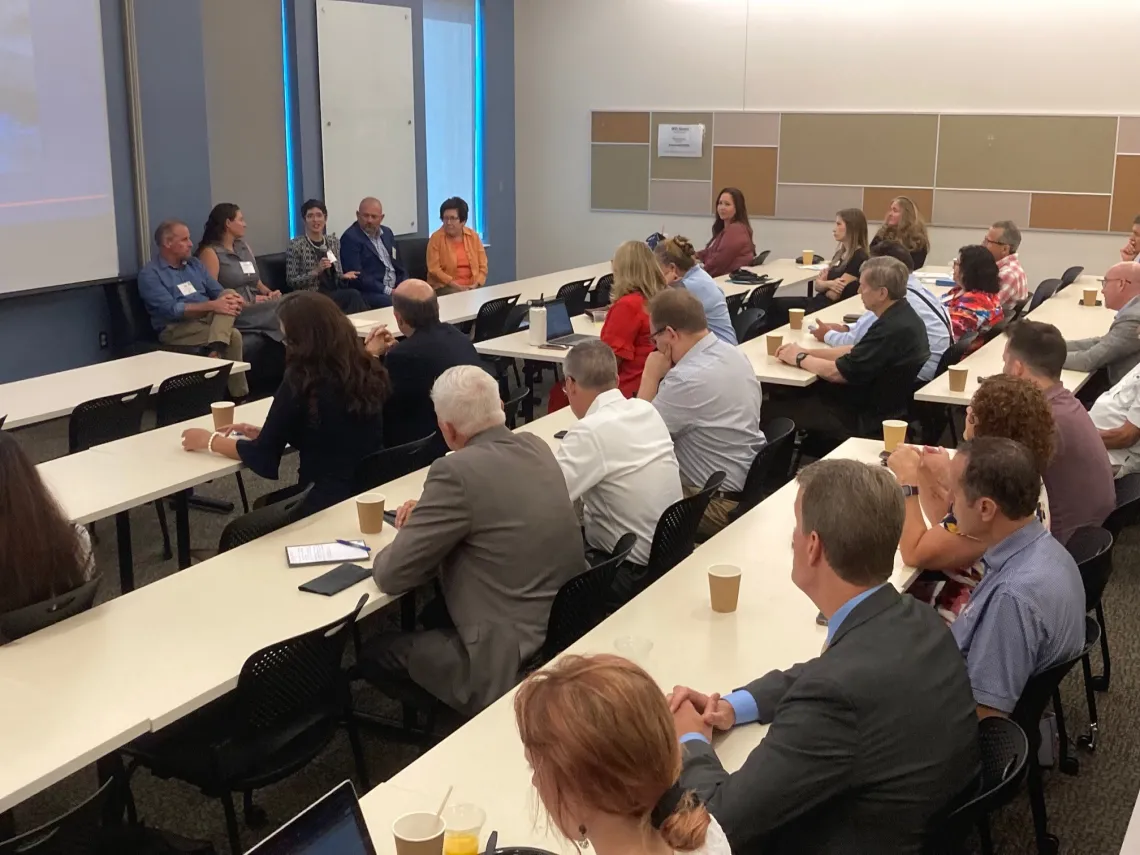Experts Engage With Community Leaders on Water Security

Sarah Prasek / Water and Energy Sustainable Technology Center
This summer, Pima County community leaders gathered with University of Arizona researchers for an interactive conversation addressing one of the Southwestern United States’ most urgent topics: water.
The event, Critical Issues for Our Community: Water Security, was organized by UArizona’s Office of Government and Community Relations and hosted at the university’s Water, Energy, and Sustainable Technology (WEST) Center, a unit within the Arizona Institute for Resilience.
“The University of Arizona has some of the world’s foremost experts on water policy,” said Julie Katsel, Assistant Vice President for Community Relations, in her opening remarks to gathered policymakers from Tucson and other areas of Southern Arizona. “You will hear from them today.”
The event included presentations by Sharon Megdal, Director of UArizona’s Water Resources Research Center, and John Kmiec, Director of Tucson Water, both of whom currently serve on Arizona Governor Katie Hobbs’ Water Policy Council.
Megdal discussed state water policy issues, and what she called “wicked water problems:” large-scale water management challenges without a single solution.
Water management in Arizona focuses on allocating the state’s water resources to support its needs. In Arizona, 72 percent of available water supports agriculture, Megdal explained, while the state’s water supply comes from a variety of sources: 41 percent from groundwater, 36 percent from the Colorado River, 18 percent from in-state rivers, and 5 percent from reclaimed water. Meanwhile, water regulation varies across Arizona, and historic water rights can be difficult to change, she said.
Kmiec provided a local perspective on long range water planning for Tucson. The city’s 10-year sustainability plan aims to support the needs of the community and industries, while integrating more options for water reuse and recycling – enhancing conservation practices that Tucson residents and industries already embrace.
“The plan takes a holistic approach that centers sustainability and equity,” Kmiec said. The goal, he explained, is to make Tucson greener and shadier, but not by using drinking water. Recovered water can be used to water golf courses, parks, and city trees, following the plan of “using a drop of water more than once.”
Tucson’s highest water usage occurred around the year 2000, Kmiec said. Since then, water usage has dropped even while the state’s population has grown.
“We call this the ‘great decoupling’ of water use,” said Kmiec. “You see the advancement of conservation practices taking hold, people consciously being aware of using less water.” The result, he said, is that “we’re now using the same amount of water as we did in the late 1980s with many more people living here.”
WEST Director Ian Pepper moderated a panel of experts including Kerri Hickenbottom, Assistant Professor in UArizona’s Department of Chemical and Environmental Engineering, Jeff Prevatt, Deputy Director of the Pima County Regional Wastewater Reclamation Department, and Channah Rock, Professor and Water Quality Specialist with UArizona’s Cooperative Extension and Department of Environmental Science.
The panelists underscored their commitment to working together to improve water reuse and recycling, sharing about active research projects that are investigating possible solutions to different water use challenges.
“We need to be able to supply a safe, secure, and cost-effective source of water to the community,” Hickenbottom said. And, she added, “We want to be the center where any policymaker or stakeholder can come to us and get information about how to create a resilient water network to meet different community needs.”
Pepper underscored Megdal’s message about the importance of Arizona agriculture. “Ninety percent of the produce that is consumed in North America between November and March is produced in Arizona,” he said. “That’s a huge component of our economic stability, and water is a huge component of that.”
WEST is partnering with growers to investigate ways to grow more crops with less water.
And Prevatt discussed a new collaboration between the county’s Regional Wastewater Reclamation Department and the U.S. Army to improve water reuse systems, make better use of water data, and train exiting military service people for civilian careers in water management.
“Municipalities are facing lack of skilled operators in wastewater planning, engineering, and science,” Prevatt said. “We developed a curriculum to recruit and train transitioning servicemembers.” A national solution, he said, born in Southern Arizona.
Following the presentations, scientists and policymakers engaged in dynamic group conversation about a variety of state water management issues, including plans for further development of advanced water purification methods and the possibility of building desalination facilities to make it possible to utilize brackish, or salty, groundwater sources.
As Megdal noted: “It’s important that we all have an understanding of baseline water policy issues,” since “we are all either decisionmakers, or decisionmaker influencers.”

